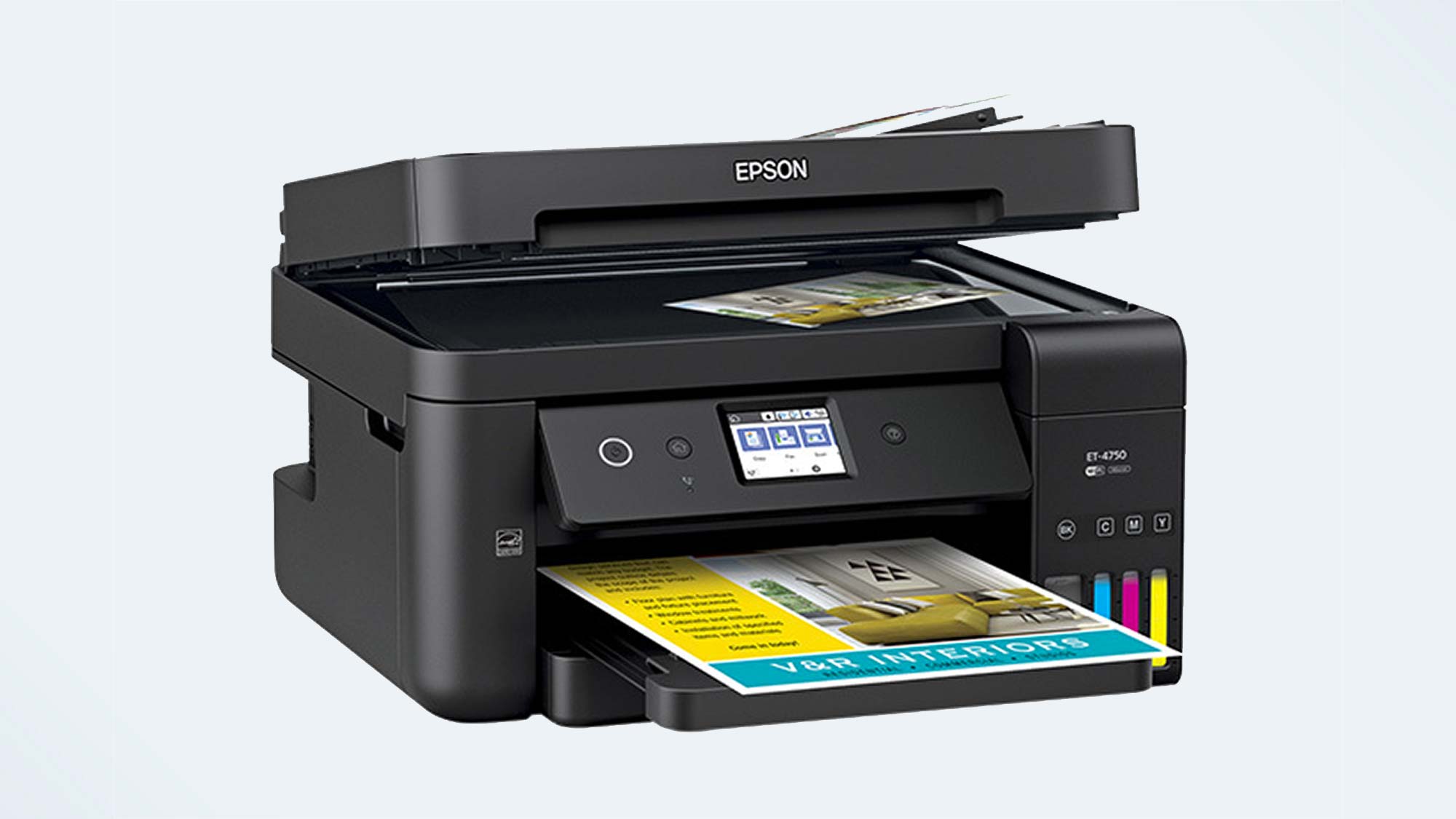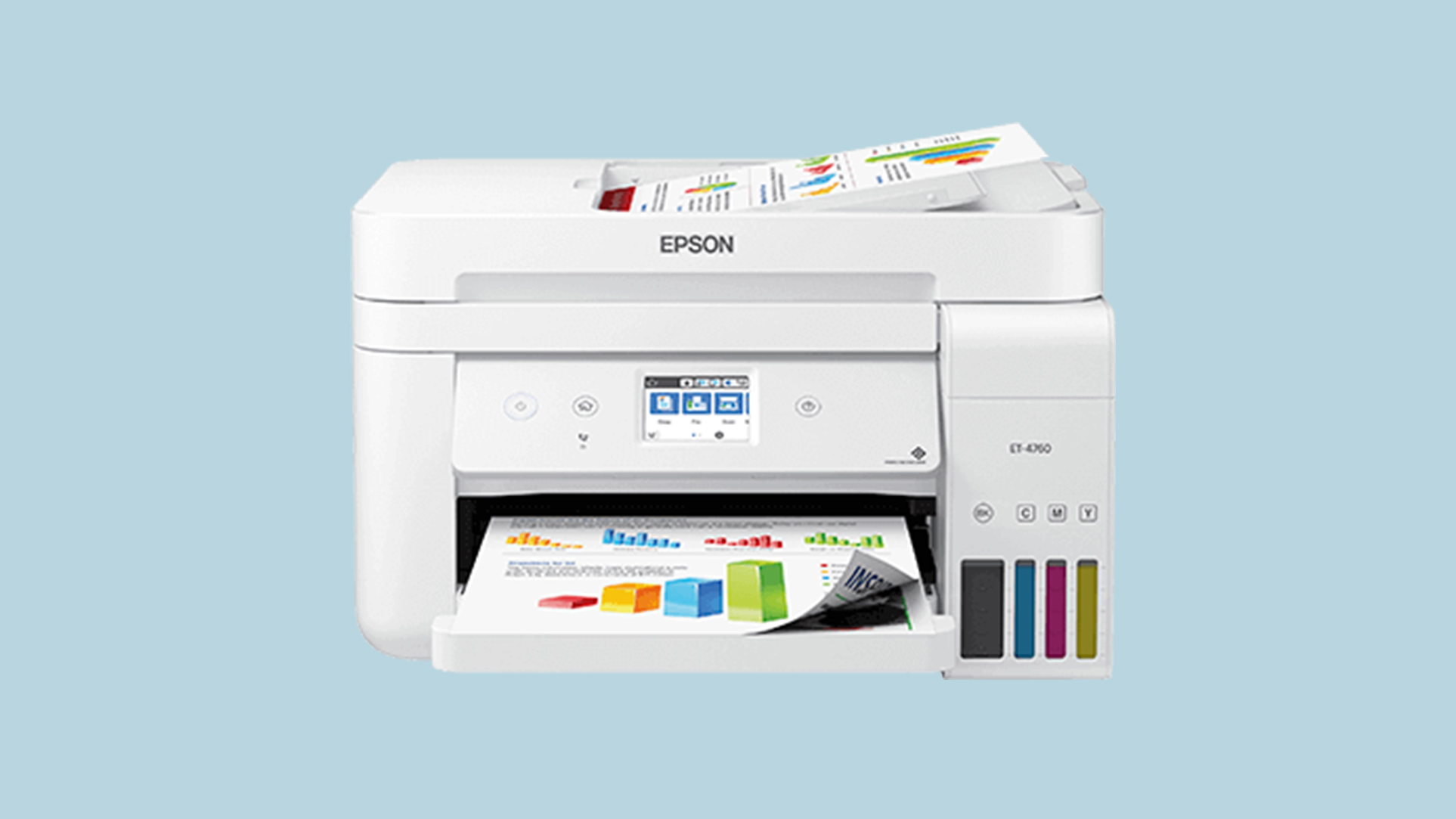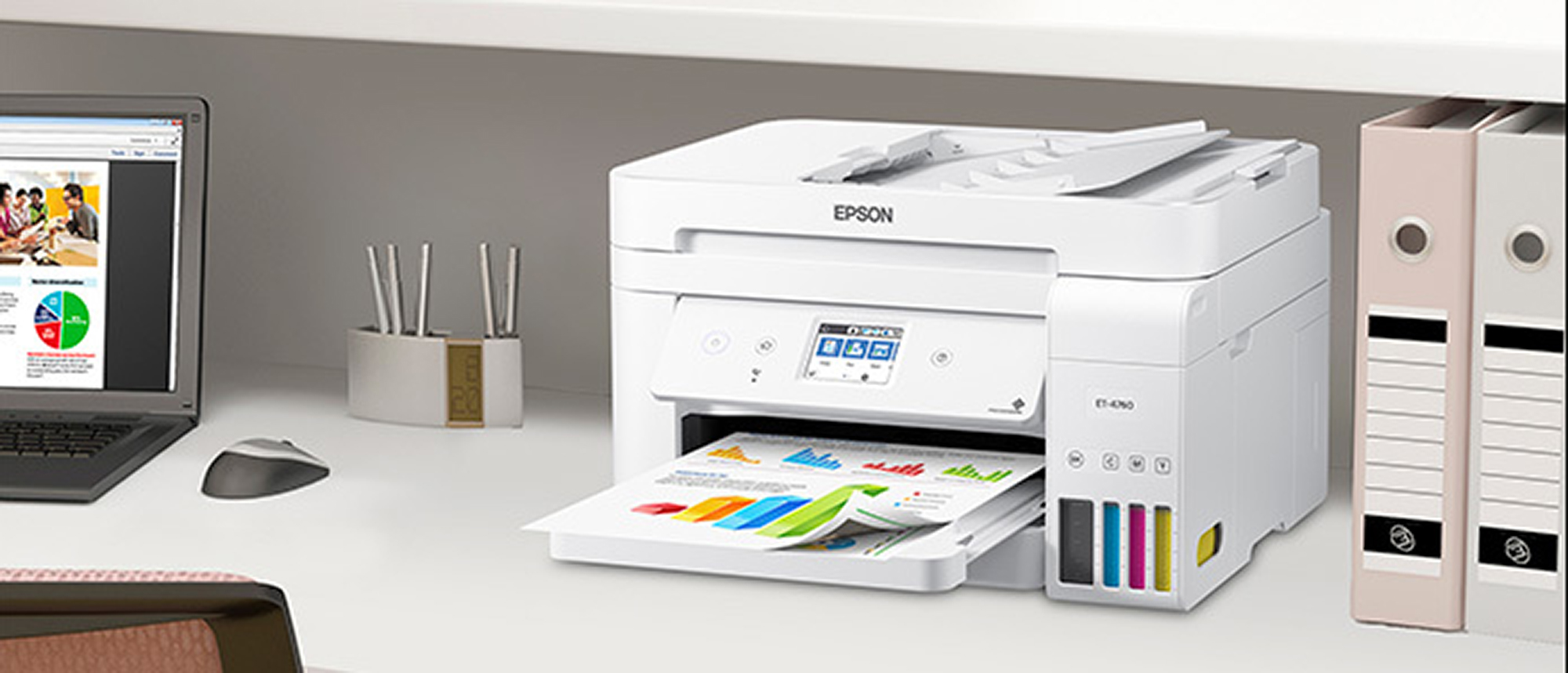Tom's Guide Verdict
The Epson EcoTank ET-4760 offers busy offices very low ink costs, plenty of features, and solid performance.
Pros
- +
Fast printing and copying
- +
Very low ink costs
- +
Quick duplexer
- +
High image quality
Cons
- -
No secondary paper tray
- -
High price
- -
Duplex prints look lighter than single-sided prints
- -
Does not make two-sided copies/scans via ADF
Why you can trust Tom's Guide
The Epson EcoTank ET-4760 ($449, or less with the right Epson coupon code) is an inkjet all-in-one that's built for heavy printing duty in a small office or home office. Outfitted with high-capacity ink tanks, the ET-4760 is built to print thousands of pages, yet keep ink costs very low.
This EcoTank model prints, copies, scans and faxes. There's a duplexer for making two-sided prints, and a 30-page automatic document feeder (ADF) for drawing multipage documents across the scanner glass. It offers a fair number of features and respectable performance, making it a contender for the best all-in-one printers. We liked it so much, we named it one of the best printers in our 2021 Tom's Guide Awards. Ink costs per page are extremely low, although your overall savings may require thousands of printed pages compared to less expensive models with office-worthy features.
Epson EcoTank ET-4760: Design
The ET-4760 has a modest-sized 2.4-inch color touchscreen on its control panel, which tilts upward almost 90 degrees. The screen is on the small side for navigating menus for stand-alone operation. The only physical buttons on the control panel are for the power, home and help functions. There is a USB port, Ethernet port and fax port, plus support for Wi-Fi and Wi-Fi Direct. There is no USB thumb drive port or memory card slot.
Like other tank models, the ET-4760 has windows into the ink tanks on its front panel, so you can see if you're running low on ink. The initial set of ink bottles should last you a while, however. The bottle of black ink is rated to print 7,500 pages, while each bottle of color ink lasts an estimated 6,000 pages.

This EcoTank is quite compact, measuring 10 x 16.4 x 19.8 inches when set up to print. It's also lightweight, at just 15 pounds. A 250-sheet paper tray is at the bottom of the unit. There isn't a secondary paper tray, so you can't keep more than one kind of paper loaded. When switching paper, you will need to change the paper type in the settings menu; paper type is not automatically detected.
The ET-4760 has a 33.6 kbps modem and can store up to 100 pages. The unit can store up to 60 speed dial numbers.
The all-in-one comes in black or a creamy off-white.
Epson EcoTank ET-4760: Print speed
The ET-4760 printed documents quickly on plain paper. It printed a five-page text document in 27.1 seconds, or 11.1 pages per minute (ppm). The average is 33.1 seconds, or 9.1 ppm. Similarly, the ET-4760 printed our six-page text and color graphics document faster than the average. It printed the document in 1 minute and 32 seconds, or 3.4 ppm. The average is 2 minutes and 16 seconds, or 2.2 ppm.
Our letter-size glossy photo printed in 4 minutes and 34 seconds. This was slightly slower than the average by 11 seconds.
Two-sided print speeds were fast. Two-sided text documents printed at 6.5 ppm, and mixed text/graphics documents printed at 3.2 ppm. While these speeds were much slower than the more expensive Epson ET-5850 (14.5 ppm and 9.5 ppm, respectively), they were much faster than the less expensive Canon Pixma G6020 (2.3 ppm and 1.8 ppm, respectively).
The ET-4760 copied a page of mixed text and color graphics in 30.1 seconds, which was faster than the average of 34.8 seconds. It also copied a black-and-white page quickly, doing so in 12.8 seconds, compared to the average of 19.2 seconds. The EcoTank scanned a page in black-and-white to PDF format in roughly average time, making the 300 dpi scan in 12.4 seconds. Scanning at high resolution to JPEG format, however, was on the slow side: Compared to the average of 1 minute and 9 seconds, the EcoTank took 40 seconds longer to make the same scan.
Epson EcoTank ET-4760: Copy and scan speed
The ET-4760 is quick at copying in black-and-white, and faster than the average at copying color documents. This EcoTank copied a color page in 30.1 seconds, versus the average of 34.8 seconds. Making a black-and-white copy of a text document in 12.8 seconds, the EcoTank bested the average of 19.2 seconds by a significant margin.
Using its ADF, a five-page text document copied in 1 minute and 7 seconds, or 4.5 ppm. By contrast, the pricier Epson ET-5850 was much faster, copying the same document at 13.8 ppm. The less expensive Canon G6020 does not have a document feeder.
The ET-4760 does not make two-sided copies from two-sided originals via its ADF.
Black-and-white scanning was a little slower than the average. The ET-4760 scanned a page in black-and-white in 12.4 seconds, versus the average of 11.6 seconds. Color scanning, however, was quite slow. It took the ET-4760 almost two minutes to capture a color document (1 minute and 49 seconds), versus the average of 1 minute and 9 seconds.
Epson EcoTank ET-4760: Print quality
Text prints with fairly sharp edges and fairly dark letterforms. Upon close examination, however, there is some ink splatter beyond the letters and some lumpy-looking edges.
Graphics looked very attractive, with well saturated colors that looked very natural. Pixels were visible in some areas where textures could have looked smoother, however, which also contributed to some fine details not looking razor sharp. Overall, however, graphics looked quite attractive.

The biggest print quality let-down was with duplex prints. Making a two-sided print of the same document, both text and graphics came out a little lighter, with a slightly washed-out appearance that made fine details look a little less sharp, and made the sense of depth look shallower.
The ET-4760 made faithful reproductions of text and graphics. Whether copied or scanned, the EcoTank captured sharp details and accurately reproduced natural-looking colors. When using the ADF, however, there were occasional anomalies in multi-page copies: One line of copied text looked stretched out and demonstrably taller than the previous one, suggesting a problem with the paper feed. Photographic scans, which came out a little dark, lost details in shadow areas. Compared to scans made by our Editor's Choice, the Canon Pixma TR9120, these scans looked darker overall, with more abrupt dark mid-tone transitions, and lacked some sharpness in the finest details.
Glossy photos printed with plenty of details, smooth textures and well-saturated colors.
Epson EcoTank ET-4760: Ink cost and yield
The ET-4760 has four ink tanks. One bottle of black ink is rated to last 7,500 pages. Each of the three colors (cyan, magenta and yellow) is rated to last 6,000 pages. The black ink costs $19.99 per bottle, and the color inks sell for $12.99 each. There is also a three-pack of color inks, but it will only save you 2 cents. No matter. With page yields this high, you'll spend just 0.2 cents per text page and 0.9 cents per color page.
So, is this ink tank model right for your wallet? That could depend on your print volume. For example, compared to the $200 Brother INKvestment MFC-J995DW, which uses ink cartridges, the ET-4760 will save you 0.7 cents per text page and 4.1 cents per color page. This assumes the MFC-J995DW is outfitted with high-yield cartridges (standard yield cartridges have a slightly higher cost per page). Given that the MFC-J995DW costs $249 more than the TR9120, you will need to print more than 35,000 text pages or 6,000 color pages to recoup that extra investment.
Epson EcoTank ET-4760: Setup and software
After removing roughly a dozen pieces of packaging tape, you fill the ET-4760's ink tanks, which is easy to do. After turning on the printer, it takes about 10 minutes for the ink charging process. The startup guide lists the URL for downloading software (there is no QR code). The software package includes a setup utility, scanning software and fax utility.
After selecting your connection type on the screen, you connect your computer (if using USB). If you choose to put the printer on your wireless network at a later time, you simply follow the on-screen menu selections, which are self-explanatory.
Before printing, you need to perform a printhead alignment. You print five pages of lines and blocks, and then select which of the seven sets is best aligned or does not overlap. This completes the setup.
The ET-4760 supports a variety of mobile apps and protocols. You can use the company's Epson Email Print, Remote Print, and Scan to Cloud apps, for example, in addition to Epson iPrint for iOS and Android. Also supported are AirPrint, Google Cloud Print and Android printing, for example.
Startup was relatively quick, with the main menu screen illuminating in 8 seconds from pressing the power button.
Epson EcoTank ET-4760: Verdict
The Epson EcoTank ET-4760 offers office-worthy features and performance, and ink costs so low you might fantasize about what you'll do with all the money you'll save. With an initial price of $449, however, you would need to print thousands of pages to make up the difference between the ET-4760 and, for example, the less expensive $200 Brother MFC-J995DW, which also offers low costs per page with its high-yield ink cartridges.
Fast printing and fast copying make this printer a good fit for a small office, and its footprint is modest, though you may miss having a second paper tray. The duplexer makes for convenient two-sided prints, but pages print lighter than single-sided documents. The printer's ADF enables quick copying and scanning, but anomalies in copied documents suggest the document feeder may not be totally reliable, which is unfortunate for an office workhorse.
All things considered, if you need an office workhorse for heavy print and copy duty—while keeping ink costs extremely low—you will most likely find the Epson EcoTank ET-4760 to be a valuable office all-in-one.
Eric Butterfield is a freelance writer and musician from California. His work has appeared in PC World magazine, CNET, Taproot, and Alter Action — plus Tom's Guide, of course — while his music has appeared in more than 260 TV show episodes for major networks such as NBC, Hulu, BBC America, and more. You can check out his work on Spotify.


